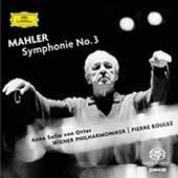|
You are reading the older HTML site
Positive Feedback ISSUE
15
Mahler: Symphony No. 3 Anne Sofie von Otter, mezzo-soprano; Women's Chorus of the Vienna Singverein and Vienna Boys' Choir; Vienna Philharmonic/Pierre Boulez DG 289 474 038-2 (2 CDs). TT: 95:23. For three movements this Third sounds like the performance of a lifetime, dispelling the disappointment that DG's immediately previous effort, the finicky, repressed Abbado/Berlin (DG 289 471 502-2), left in its wake. Unfortunately, the end of the performance fails to fulfill its initial promise. A proud, clearly etched horn proclamation sets the tone for the lengthy first movement. Where Abbado observed the score's numerous piano markings so scrupulously as to drain the color from the score, Boulez, equally faithful to the indicated dynamics, draws the main lines in sharp relief and keeps the rhythms springy and pointed, bringing the play of colors and textures to vivid life. The taut, no-nonsense trombone solo at 7:00 holds the discourse together without straining at metaphysical gnats. If anything, the little duet for horn and solo violin at 18:51, which usually sounds a bit off-kilter rhythmically—and I suspect the ambiguity is intentional—sounds too clear and well-organized here. The tempo for the march episode is held back more than the norm, allowing the basses to support their springy dotted rhythms with some tonal fiber. I was disappointed to hear the superfluous rhetorical ritard setting up the climax at 32:24, but Boulez recovers the pulse quickly. The oboe's vernal simplicity in the Menuetto's opening phrases bespeaks a properly intermezzo-like respite, but not an entirely uneventful one, with the strings evoking unease as they shift into the minor. In the later variations, the Vienna violins become glassy high above the stave, as they are prone to do, but they execute their florid embellishments deftly. The Scherzando, which like the first movement can seem too much of a good thing, here sounds perfectly, inevitably proportioned. For once, the melody is clearly discernible through the surrounding textures at 5:18. The offstage "posthorn" solo—soloist and actual instrument unbilled—is nicely distanced, yet maintains a clear presence vis-a-vis the accompanying onstage horns. And the coda's big outburst, burgeoning rapidly as in time-lapse nature photography, propels the movement to a walloping finish. In the Nietzsche song, Boulez realizes the orchestral cross-rhythms—triplets, quintuplets, sestuplets and the like, variously layered over a steady pulse—better than anyone else I've heard. But, though Anne Sofie von Otter offers a warm, evenly produced voice, impeccable musicianship, and a sensitive, detailed response to the text, she is miscast in writing that calls for an "Earth-mother" contralto. (The music mysteriously rises, like Wagner's Erda, from the bowels of the earth.) The "bimm-bamm" movement is fine, though the trombone at 3:23 is distinctly restrained in its jubilation. The concluding Adagio encompasses striking dramatic contrasts among wide-ranging sonorities and textures, requiring a variety of subtle and not-so-subtle tempo adjustments. Some high-profile conductors have run aground here simply by setting an incorrect basic pulse: Solti (Decca, twice) and Barbirolli (BBC Legends) are brisk and brutal, while Levine's (RCA) self-conscious crawl reduces the movement to a series of stiff, wooden gestures. To his credit, Boulez doesn't fall into either of these traps; the problem is, he doesn't do much of anything else. The broad opening theme is flowing, but too plain and offhand—no little "leans" into the important cadences, no vibrancy in the string sonority (even the high divided violins lack shimmer). In short, nothing animates this deadpan, under inflected reading. Boulez's attention to detail remains comprehensive: he provides incisive accents notes in the anxious contrasting passages and underlines the climaxes with powerful brasses, but even these sound oddly uncommitted. The flute evokes one striking moment of desolation at 15:41 over the string tremolos. But it's too little, too late. Ironically, Abbado rouses himself from his torpor in this movement, finally allowing the strings to vary dynamics so as to draw expression from their lines, so his reading ends up leaving the more positive impression, even though Boulez's is considerably more interesting overall! So the Mahler Third situation remains much as it was before the spate of recent releases: Horenstein (buried in the mixed Mahler box on Brilliant Classics) for somber authority and a classical sense of proportion, and the Haitink/Berlin (Philips) for drama, color, and up-to-date sonics. Stephen Francis Vasta
|

